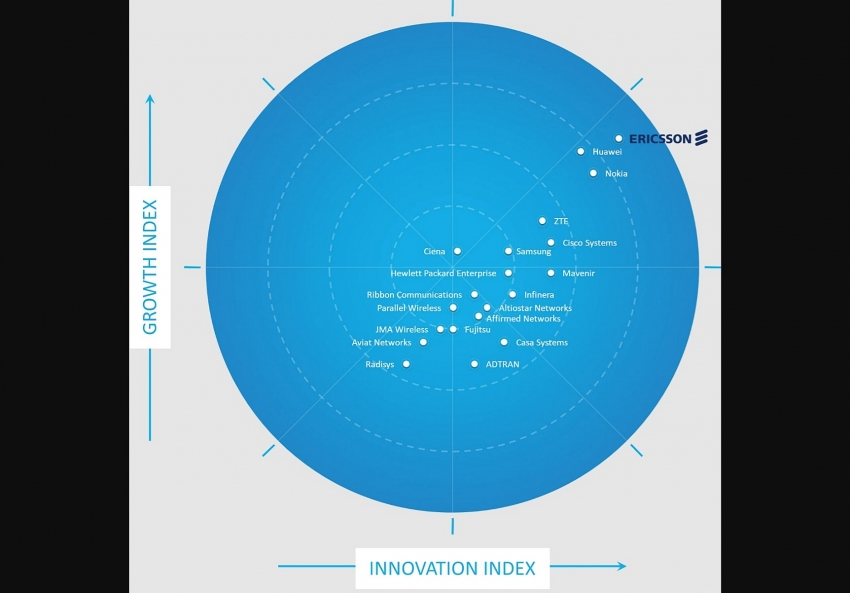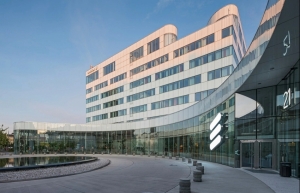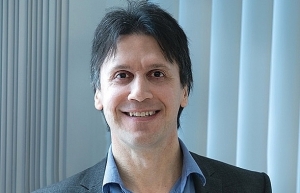Ericsson named leader in global 5G network infrastructure market 2020
 |
| Ericsson topped the 5G infrastructure market in the latest Frost Radar |
Ericsson ranks highest in the 5G network infrastructure market in the latest Frost Radar, leveraging its current leadership in 4G network infrastructure market. According to Frost & Sullivan, the 5G network infrastructure market includes radio access networks (RAN) as well as transport networks and core networks, which may include one or more edge networks.
In its latest report, Frost & Sullivan independently plotted the top 20 companies from a field of more than 100 global industry participants. These companies either lead the market overall, lead a market segment, or were thought leaders in certain segments. The Frost Radar reveals the market position of companies in a particular industry using their Growth and Innovation scores as highlighted in the Frost Radar methodology.
Denis Brunetti, head of Ericsson Vietnam, Myanmar, Cambodia and Laos stated, “At Ericsson, we continue to invest in research and development (R&D) to build best-in-class and innovative product solutions for our customers. Being recognised as the leader in Frost Radar reinforces our technology leadership, market competitiveness, innovation, and most importantly, our commitment to our customers. We will continue to further strengthen our 4G/5G portfolio to meet the needs of our customers.”
Growth and Innovation indices
The Frost Radar measures growth rates and absolute revenue, combining them with several other factors to measure a company’s performance along the Growth axis. It also measures innovation for each company by assessing its product portfolio, examining how scalable its innovations are and looking at the efficacy of its R&D strategy, as well as other factors.
Commenting about Ericsson and the Growth Index, Troy Morley, senior industry analyst, Frost & Sullivan’s Information & Communication Technology group, said: “As a leader in the 4G infrastructure market, Ericsson enters the 5G market with a large customer base. The company has done an excellent job keeping its current customers and adding new customers… Ericsson maintains a significant pipeline of customers that have yet to move to 5G but will over the coming years. Ericsson has spent the past few years adjusting its overall strategy to focus on profitability. The company recently indicated that the turnaround has been successful, and the company has significantly improved profitability and its financial position.”
With regard to Ericsson and the Innovation Index, Morley said: “Ericsson has proven its ability to scale its innovations globally with 2G, 3G, 4G, and now 5G. For 5G, the company currently reports 72 live 5G networks in 37 countries (the highest level Frost & Sullivan has seen publicly reported). The company invests significant amounts in R&D; this is essential in a market where technology is always evolving.”
A leading 5G portfolio
 |
| Ericsson outperformed global competition both in growth and innovation |
Ericsson has evolved its end-to-end 5G offerings to include the Ericsson Radio System, 5G Core, Orchestration and 5G Transport as well as professional services. The company has introduced innovative software solutions such as Ericsson Spectrum Sharing, 5G carrier aggregation and Uplink Booster, to significantly improve coverage, user throughput, and spectral efficiency.
These solutions support service providers in deploying and evolving 5G to ensure the best end-user experience. In addition, Ericsson Radio System products delivered since 2015 can support 5G New Radio (NR) capability through remote software installation.
Ericsson Digital Services offers a cloud native dual-mode 5G Core solution for smarter networks to drive smarter business, allowing communications service providers to offer a multitude of new business opportunities for mobile users and industries. Ericsson network automation solutions will improve network efficiency, performance, customer experience, and enable new revenue streams for new 5G use cases.
In February, Ericsson was also named a Leader in the 2021 Magic Quadrant for 5G Network Infrastructure for Communications Service Providers by independent IT research and advisory company, Gartner.
What the stars mean:
★ Poor ★ ★ Promising ★★★ Good ★★★★ Very good ★★★★★ Exceptional
Themes: Digital Transformation
Related Contents
Latest News
More News
- First members of Danang International Finance Centre revealed (December 22, 2025 | 17:39)
- Human-centred governance seen as key to AI development (December 19, 2025 | 18:19)
- Top 10 notable events of Vietnam’s industry and trade sector in 2025 (December 19, 2025 | 14:00)
- Tungsten surges to 12-year high as world enters a new 'black gold' race (December 18, 2025 | 17:27)
- Vietnam’s coffee exports set new record despite price pressures (December 18, 2025 | 17:13)
- Garment and textile sector seeks new growth after volatile year (December 18, 2025 | 17:01)
- VinSpeed and Siemens strengthen cooperation for high-speed rail development (December 18, 2025 | 16:53)
- High-tech adoption for TH true MILK (December 18, 2025 | 13:39)
- Takeda supports health resilience amid climate change challenges (December 18, 2025 | 12:39)
- Mondelez Kinh Do - a chapter of purpose-led leadership in Vietnam (December 18, 2025 | 09:44)





 Tag:
Tag:



























 Mobile Version
Mobile Version